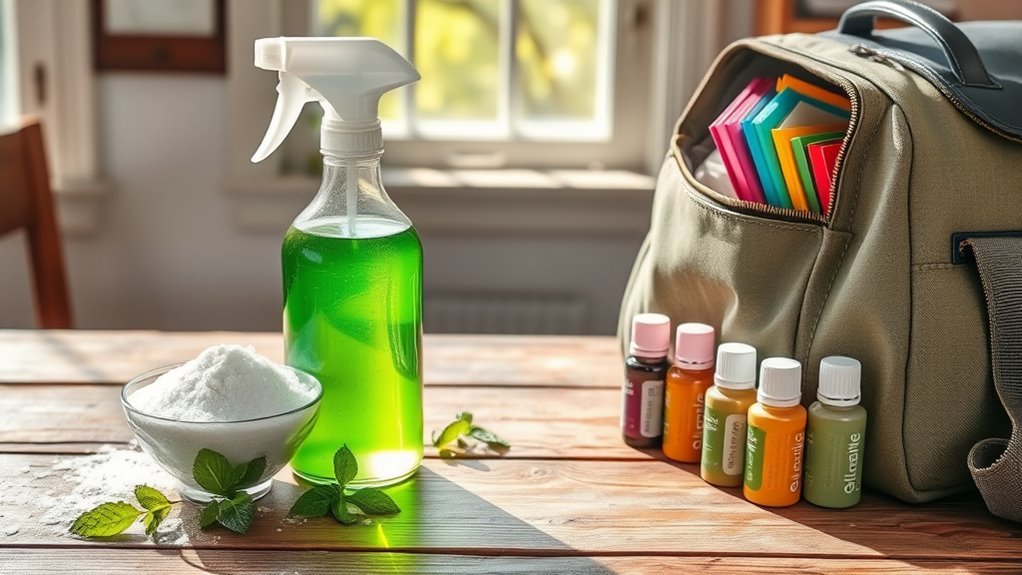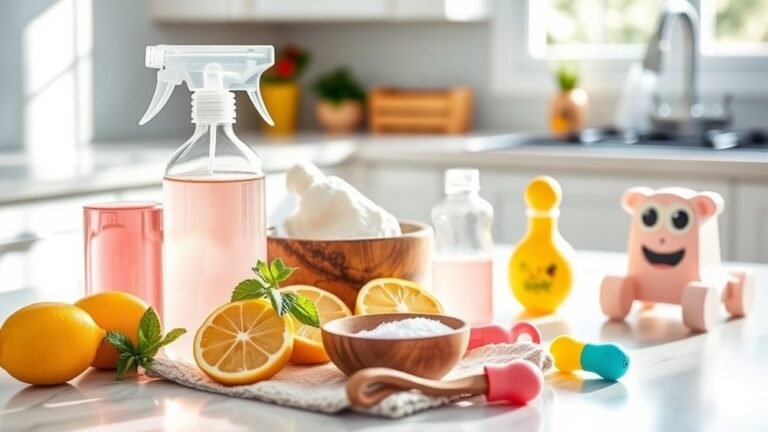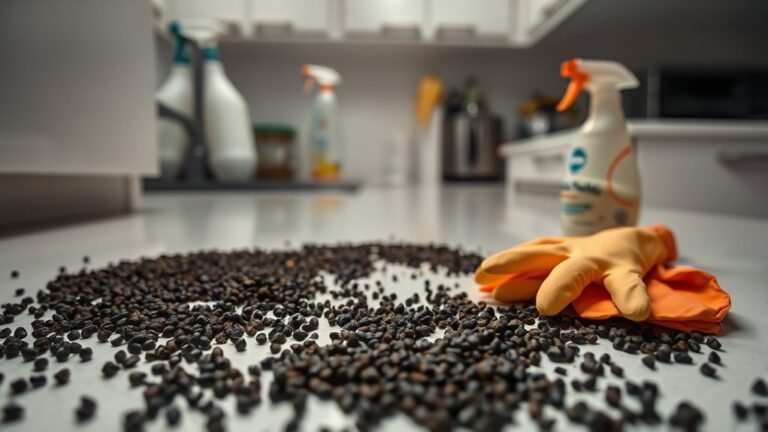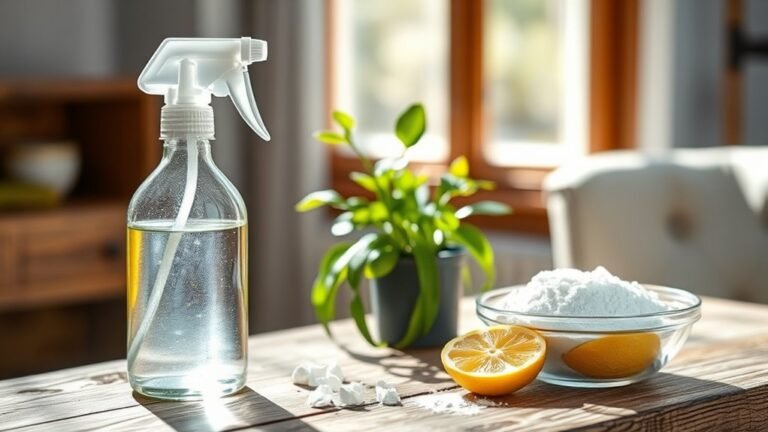Budget-Friendly DIY Cleaning Products for School Bag
You can clean your school bag affordably with simple DIY products like a mix of water, white vinegar, and liquid castile soap for gentle all-purpose cleaning. For stains, make a baking soda paste applied directly, then scrub and rinse. To freshen odors, try a spray of water, witch hazel or vodka, and essential oils like lavender. These natural solutions are safe for fabrics and leather, helping you maintain a fresh, clean bag with minimal cost. Discover more easy tips to keep your bag spotless and smelling great.
Essential Ingredients for DIY Cleaning Solutions

Before you begin making your own cleaning products for your school bag, it’s important to gather the right essential ingredients that are both effective and safe. You’ll want to focus on eco friendly alternatives like white vinegar, baking soda, and castile soap, which clean thoroughly without harsh chemicals. These staples provide versatility while ensuring cleaning safety, as they’re gentle on your bag’s materials and non-toxic. Essential oils, such as tea tree or lavender, add natural antibacterial properties and pleasant scents. Make sure to measure ingredients precisely to avoid damage or residue. By choosing these simple, natural components, you maintain control over what touches your belongings, promoting a chemical-free routine that supports your freedom to clean responsibly and sustainably.
How to Make a Gentle All-Purpose Cleaner
Once you have your natural ingredients ready, you can create a gentle all-purpose cleaner that’s perfect for maintaining your school bag. Start by mixing 1 cup of distilled water with 1/4 cup of white vinegar and 1 tablespoon of liquid castile soap. Add 10 drops of your favorite essential oil for a fresh scent. This gentle formula cleans effectively without harsh chemicals, making it safe for fabric and leather surfaces. Pour the mixture into a spray bottle for easy use. Its versatile applications include wiping down zippers, straps, and interior linings to remove dirt and odors. Always test a small hidden area first to verify colorfastness. This DIY cleaner offers you freedom from commercial products, letting you maintain your bag naturally and affordably.
Removing Stubborn Stains With Baking Soda Paste
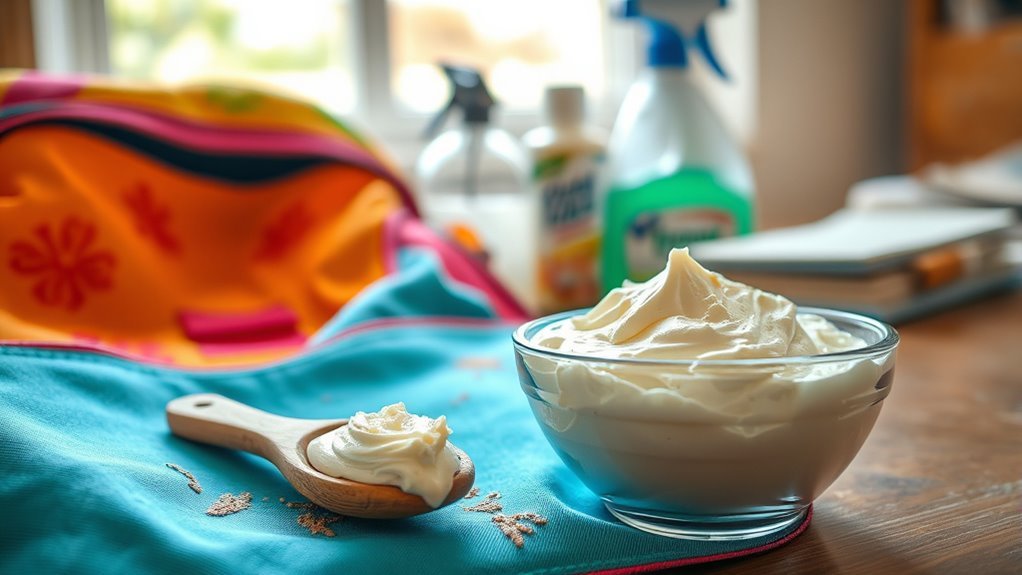
A baking soda paste is a powerful yet gentle solution for tackling stubborn stains on your school bag. To make it, mix three parts baking soda with one part water until you get a thick, spreadable paste. Apply this directly onto the stained area, ensuring full coverage. Let it sit for 15 to 20 minutes, allowing the baking soda’s mild abrasiveness and natural stain removal properties to work. Afterward, gently scrub the paste with a soft brush or cloth, focusing on the stain without damaging the fabric. Finally, wipe away the residue with a damp cloth and let your bag air dry. This method offers an effective, budget-friendly way to refresh your bag without harsh chemicals, giving you freedom from stains while keeping your cleaning routine simple.
Natural Deodorizing Sprays to Eliminate Odors
After tackling tough stains with baking soda paste, you might notice lingering odors in your school bag that need attention. A natural deodorizing spray is your best bet to refresh it without harsh chemicals. Here’s how you can create one:
- Combine 1 cup of distilled water with 2 tablespoons of witch hazel or vodka as a natural preservative.
- Add 10-15 drops of your favorite essential oils, such as lavender, lemon, or eucalyptus, for a pleasant natural scent.
- Shake well and transfer to a spray bottle. Lightly mist the inside of your bag and let it air dry.
This simple spray eliminates odors while leaving a fresh, natural scent, keeping your school bag smelling clean and inviting.
Using Vinegar Solutions for Deep Cleaning

Vinegar solutions offer an effective and natural way to deep clean your school bag, tackling dirt, grime, and even stubborn odors. The vinegar benefits include its antibacterial properties and ability to break down buildup without harsh chemicals. You can make a simple solution by mixing equal parts water and white vinegar. If you prefer vinegar alternatives, lemon juice or baking soda can also work but may vary in effectiveness.
| Cleaning Aspect | Vinegar Solution | Vinegar Alternatives |
|---|---|---|
| Removes Odors | Neutralizes and eliminates | Lemon juice masks odors |
| Disinfects | Kills bacteria naturally | Baking soda deodorizes |
| Stain Removal | Breaks down dirt and grime | Less effective on tough stains |
Use vinegar solutions regularly for a fresh, clean bag.
Quick Spot Cleaning Techniques for School Bags
When spills or stains happen unexpectedly, you’ll want to act quickly to prevent permanent marks on your school bag. Mastering spot cleaning techniques is key to preserving its look without a full wash. Here’s a simple approach:
Act promptly on stains to keep your school bag looking fresh without needing a full wash.
- Blot the stain gently with a clean cloth to absorb excess liquid—don’t rub, as that can spread the stain or damage fabric fibers.
- Prepare a mild cleaning solution by mixing a few drops of gentle detergent with water. Use a soft brush or cloth to apply it precisely to the affected area.
- Rinse the spot carefully with a damp cloth, then let it air dry completely.
These fabric care steps help maintain your bag’s integrity, giving you freedom from worrying about small messes turning into big problems.
Tips for Maintaining a Clean and Fresh Bag
Although regular deep cleaning is important, maintaining your school bag’s cleanliness daily can prevent dirt buildup and unpleasant odors. Establish a maintenance schedule to keep your bag fresh and organized. Focus on bag organization by removing trash, wiping surfaces, and airing out the bag routinely. This simple routine extends your bag’s lifespan and keeps it ready for use.
| Task | Frequency |
|---|---|
| Empty and declutter | Daily |
| Wipe exterior | Weekly |
| Clean interior lining | Biweekly |
| Air out bag | After each use |
Following this schedule helps you avoid overwhelming cleaning sessions and keeps your bag smelling fresh. With consistent care, your school bag stays tidy, functional, and ready for whatever your day brings.
Safe Storage and Handling of Homemade Cleaners
When storing your homemade cleaners, make sure to use containers that are sturdy and airtight to prevent leaks or spills. Always label each container clearly with its contents and any safety warnings to avoid accidental misuse. Keep these cleaners out of reach of children and away from food or heat sources for maximum safety.
Proper Container Selection
Because homemade cleaners can contain potent ingredients, choosing the right container is essential to guarantee safety and maintain their effectiveness. When selecting container types, consider materials that won’t react with your DIY formulas. Glass and certain plastics like HDPE are excellent storage solutions because they’re durable and chemical-resistant.
Here are three tips for proper container selection:
- Use airtight containers to prevent spills and preserve the cleaner’s potency.
- Opt for containers with secure lids to avoid accidental leaks during transport.
- Choose sizes that match your usage frequency—smaller containers for daily use reduce exposure risk.
Labeling and Safety Tips
If you want to keep your homemade cleaners effective and safe, clear labeling is a must. Use simple labeling methods like waterproof stickers or permanent markers to note the product name, ingredients, and date made. This helps you avoid confusion and guarantees you use each cleaner before it loses potency. Alongside labeling, follow safety precautions: store cleaners in a cool, dry place away from children and pets. Always keep containers tightly sealed to prevent spills and contamination. Avoid mixing products unless you’re certain it’s safe. When handling, wear gloves if you have sensitive skin and wash hands afterward. These steps not only protect you but also maintain the quality of your DIY products, giving you freedom to clean confidently and responsibly.
Frequently Asked Questions
Can DIY Cleaners Damage Certain Types of School Bag Materials?
You should be careful with material compatibility when using DIY cleaners on your school bag. Some materials, like leather or suede, can be damaged by harsh ingredients or leftover cleaner residue. Always test a small, hidden area first to see how the fabric reacts. If you notice discoloration or texture changes, avoid that cleaner. Choosing gentle, natural ingredients helps keep your bag safe while giving you freedom to clean effectively.
How Often Should I Clean My Child’s School Bag?
You don’t want your child’s school bag turning into a science experiment, right? For proper bag maintenance, aim for a cleaning frequency of at least once a month. If your kid’s a little messy or the bag faces daily spills, twice a month works better. Regular cleaning prevents odors, stains, and wear, freeing you from unexpected scrubbing marathons. Keep it practical—wipe down surfaces weekly and deep clean monthly for lasting freshness.
Are These DIY Cleaning Products Safe for Kids to Use?
You’ll want to make sure the DIY cleaning products you use contain kid friendly ingredients like vinegar, baking soda, and gentle soap. These are safe for little hands when used properly. Always supervise your child during cleaning and store all mixtures in clearly labeled, secure containers away from their reach to prevent accidental ingestion. This way, you can keep your kid safe while enjoying effective, natural cleaning solutions that you both can trust.
Can These Homemade Cleaners Be Used on Lunch Boxes Too?
Just like Sherlock Holmes would scrutinize every clue, you should consider lunch box materials before using homemade cleaners. These cleaners often work well on plastic, stainless steel, or silicone, effectively removing grime without harsh chemicals. However, avoid applying them on insulated or fabric-lined boxes without spot testing first to ascertain homemade cleaner effectiveness. With careful use, you’ll keep lunch boxes fresh and safe, giving your child freedom from harmful residues.
What Should I Do if a DIY Cleaner Causes an Allergic Reaction?
If you experience allergy symptoms after using a DIY cleaner, stop using it immediately and wash the affected area with water to remove any residue. Consider consulting a healthcare professional if symptoms persist or worsen. To avoid this in the future, explore cleaning alternatives with gentler, hypoallergenic ingredients. Always test a small area first and guarantee good ventilation while cleaning to reduce the risk of allergic reactions and maintain your freedom to clean safely.
